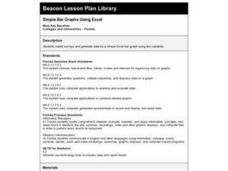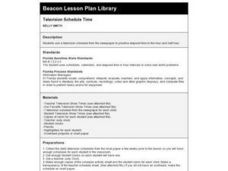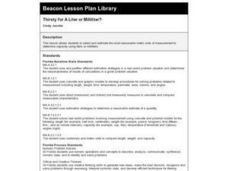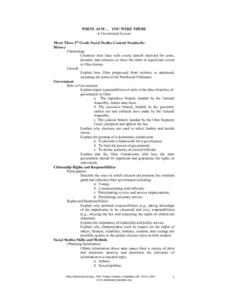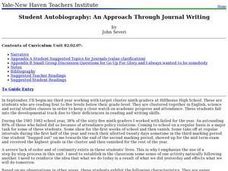Curated OER
Simple Bar Graphs Using Excel
Students create original survey questions, and develop a bar graph of the data on paper. They input the survey data using two variables onto an Excel bar graph spreadsheet.
Curated OER
Television Schedule Time
Students consider the concept of elapsed time by examining television schedules. They list five television shows and highlight them in a newspaper, marking down the beginning and ending time of each show. They use clocks to figure out...
Curated OER
Thirsty for A Liter or Milliliter?
Second graders work with liters and milliliters for measurement.
Curated OER
Shadows
Students measure shadows at different times of the day to determine when a shadow casts its longest and shortest shadows.
Curated OER
ALASKA-CANADA HIGHWAY PROBLEM
Learners create a table of ordered pairs, using variables (dependent and independent), writing equations, converting metric and standard measurements for distance using mileposts.
Curated OER
Chills And Thrills
Students learn what happens when ice melts. They explore melting, and devise ways of speeding up and slowing down the melting process.
Curated OER
Risky Business
Students view a video on AIDS, HIV and the ways in which HIV is spread. They discuss ways to avoid contracting HIV and participate in a simulation that shows the growth of a communicable disease.
Curated OER
Balance and Flux Reveal How Organisms Are Connected in Ecosystems
Students read about cats in Borneo and discuss role predators play in controlling population size. They map the interdependencies among species. They read about flux in ecosystems and complete a worksheet.
Curated OER
Behind the Movie Chicago
Students explore the genre of the musical film and its history. They draw conclusions on relationships between a stage musical and a musical film. They share the results of their research as a class.
Curated OER
Fire Tag
Fourth graders discuss and practice the correct way to stop, drop, and roll in the case of a fire. They play a tagging game to help them with this procedure.
Curated OER
The Little Ice Age - Understanding Climate and Climate Change
Fourth graders receive data about tree ring records, solar activity, and volcanic eruptions during the Little Ice Age (1350-1850). From this data, they draw conclusions about possible natural causes of climate change
Curated OER
Walking Math into the Real World
Middle schoolers measure an area given a yardstick. They also convert inches into a fractions of a foot and use data to create a linear graph.
Curated OER
Write As If...You Were There
Fourth graders use their imagination to create a story about being present when the Great Seal of Ohio was designed. They draw a picture of the Great Seal of Ohio.
Curated OER
Ohio's U.S. Presidents
Fourth graders investigate the state of Ohio's claim to be the "Mother of Presidents." Nine U.S. presidents were from the state and their contributions and terms of office are examined in this lesson.
Curated OER
Prehistoric Native American Lesson Plan: Pictionary with the Past
Students participate in a vocabulary exercise at a website dedicated to Prehistoric Native Americans.
Curated OER
Igneous Rocks
Students perform experiments in which they grow crystals. They draw pictures of where each type of rock originates from. They also identify igneous rocks by using a chart.
Curated OER
Production and Costs
Students discuss the concept of productivity and participate in an activity in which they test their own productivity in making Origami cups. Teams determine how to improve productivity and then discuss factors that influence...
Curated OER
Learning New Words
Students, working in groups, make as many words as possible in a given time, using flash cards that contain prefixes, words, and definitions. They chose group roles and participate in a numbers of time rounds of this activities.
Curated OER
Sea Ice and Sheet Ice Melting Experiment
Students observe the change in water level as a result of melting sea ice and melting sheet ice.
Curated OER
Marine & Aquatic Habitats Activities - Marine Ecology
Students enact the life cycle of a sessile animal and quantify the possibility of survival under the conditions given. They then present to the class a new adaptation which will increase the animals chance of survival.
Curated OER
Understanding Topographic Maps
Students are introduced to the characteristics and uses of topographical maps. Using a worksheet, they examine the use of specific terminology and use cutouts to create their own topographical map of an area. They answer discussion...
Curated OER
Student Autobiography: An Approach Through Journal Writing
Students write about an ordinary, everyday happening such as riding in the family car, preparing for school in the morning, doing the wash, shooting a foul shot or sitting in English class. They look at how he/she spends time during the...
Curated OER
Accordion Book for Comparing Cultures
Fourth graders are introduced to the different cultural groups that have settled in Ohio. In groups, they research and describe the products and cultural practices of each group. Using the information, they create an accordion book for...
Curated OER
Graphs Galore
Fourth graders conduct surveys to collect data. They analyze and interpret the data, then determine which type of graph is appropriate for the data. Students use the data to make predictions, discover patterns and draw conclusions...
Other popular searches
- 5 Minute Intervals
- Major Intervals
- Interval Notation
- Class Interval
- Music Theory Interval
- Music Intervals
- 1 Minute Intervals
- Interval Training
- Intervals Number Line
- Five Minute Intervals
- Contour Intervals
- Graph Intervals


